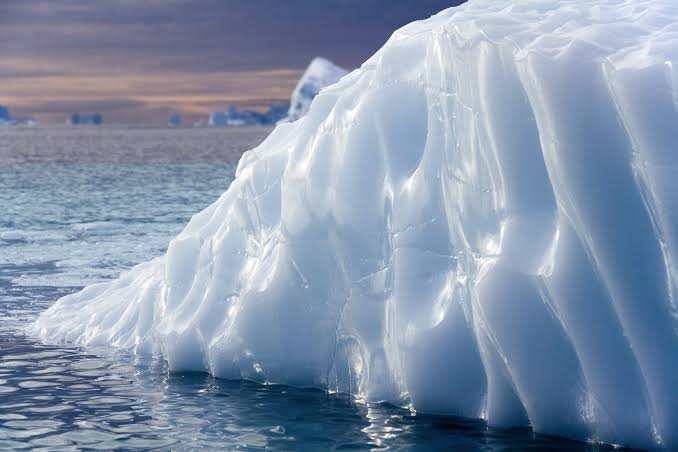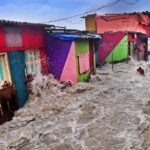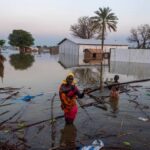Authors – RUPAL GURJAR and NANCY YADAV
Title – Water as a Geopolitical Weapon: Climate Change, the Brahmaputra River, and Arctic Tensions
Abstract
Climate change is worsening water scarcity, turning water resources into instruments of geopolitical power. This research explores the weaponization of water through two specific case studies: the Brahmaputra River and the geopolitical transformations occurring in the Arctic. By employing comparative analysis, policy examination, and quantitative data, this study underscores how changes in precipitation and melting ice influence regional stability. The results indicate that climate change not only escalates existing conflicts but also gives rise to new areas of contention.
Introduction
Water, which was once mainly a basic necessity for human survival, is now increasingly used as a weapon due to the rising impacts of climate change. The strategic manipulation of water resources, driven by shortages and changing environmental conditions, presents serious risks to both regional and global stability. This article examines two pivotal case studies: the Brahmaputra River, traversing China, India, and Bangladesh, and the developing geopolitical environment of the Arctic. These examples highlight the various ways climate change affects water-related politics, from intensifying existing conflicts to generating new areas of strife. “Weaponization” refers to the deliberate control or manipulation of water access for political, economic, or military gain. This study seeks to evaluate how climate change alters these dynamics and suggests policy measures to promote sustainable water management.
Literature Review
Water Scarcity and Hydro-Politics
Water scarcity has historically been acknowledged as a catalyst for geopolitical conflicts. As noted by Zeitoun and Warner (2006), hydro-hegemony theory elucidates how dominant nations leverage their upstream position to exert influence over shared water resources, often harming weaker neighboring countries. This phenomenon has been observable in several river basins, where upstream nations implement strategies such as constructing dams, redirecting water, and engaging in negotiations to protect their interests. With climate change exacerbating water scarcity, these hydro political disputes are predicted to increase in both frequency and intensity.
Climate Change and Water Security
In his book Environment, Scarcity, and Violence (Princeton University Press, 1999), Thomas Homer-Dixon posits that environmental scarcity, with a focus on water shortages, has a significant effect on security, leading to both inter-state and intra-state conflicts. The swift retreat of glaciers, alterations in precipitation patterns, and the rise in extreme weather events are placing pressure on existing water agreements and compelling nations to reconsider their strategies for resource management. This situation is particularly crucial for areas like South Asia, where millions rely on cross-border rivers for their livelihoods.
Methodology
This research relies on a qualitative assessment of available literature, publicly accessible reports, and secondary data sources. Rather than undertaking primary data collection through expert interviews or direct policy evaluations, the study focuses on a methodical review of academic and policy-related literature to explore the implications of climate change on water geopolitics.
- Literature Review: An extensive analysis of books, journal articles, and reports regarding water security, climate change, and geopolitical tensions was performed. Significant theoretical frameworks, such as hydro-hegemony and environmental security, directed the analysis.
- Case Study Approach: The Brahmaputra River and the Arctic region were chosen as case studies because of their geopolitical importance and the effects of climate change on their water resources. This study evaluates existing research and publicly available information to investigate water-related conflicts within these areas.
- Secondary Data Analysis: Data from organizations like the Intergovernmental Panel on Climate Change (IPCC) and the World Resources Institute (WRI) were utilized to comprehend evolving hydrological patterns and their geopolitical consequences.
- Thematic Analysis: The information gathered was organized into major themes, including water scarcity, climate change, and geopolitical conflicts, to recognize trends and formulate conclusions.
Case Study Analysis
Brahmaputra River:
The Brahmaputra River, a significant international waterway that begins in the Tibetan Plateau, flows through China (Tibet), India, and Bangladesh before merging with the Bay of Bengal. This river system is a vital water source for millions, supporting critical sectors like agriculture, hydropower production, and the livelihoods of communities in these bordering nations. However, the river’s strategic significance has also led to increasing tensions among these countries, a situation worsened by the severe effects of climate change that are changing hydrological patterns and heightening water disputes.
Strategic Value of the Brahmaputra River
The Brahmaputra River possesses considerable strategic importance for each bordering nation. In China, referred to as the Yarlung Tsangpo, the river is fundamental to the country’s aspirations for hydropower. The development of several dams, such as the Zangmu Dam, and proposed mega dam initiatives near the Great Bend emphasize this focus, raising significant concerns for those downstream (Modak, 2020). For India, the river is crucial for providing essential water resources to the northeastern states of Assam and Arunachal Pradesh, supporting agricultural and hydroelectric efforts. Furthermore, its proximity to disputed areas gives it strategic security relevance. For Bangladesh, the lowest riparian country, the Brahmaputra is essential for irrigation, drinking water, and transportation. Nonetheless, this nation is especially susceptible to both climate-related changes and upstream actions that jeopardize its water security.
Effects of Climate Change on the Brahmaputra River
Climate change has drastically modified the hydrological dynamics of the Brahmaputra. The swift retreat of Himalayan glaciers, a direct outcome of rising global temperatures, has caused notable changes in seasonal water availability. While the initial increase in glacial melt has led to higher river flows, long-term forecasts suggest significant water shortages. Additionally, more intense monsoon rains have raised the frequency and severity of flooding, particularly in Assam and Bangladesh, leading to extensive displacement and damage to infrastructure. Changes in sediment deposition patterns, driven by increased erosion and temperature changes, are affecting agriculture and navigation. In Bangladesh, higher sea levels are causing the intrusion of saltwater into freshwater systems, endangering agricultural productivity and drinking water resources, and heightening the vulnerability of the delta.
Geopolitical Conflicts and Rising Disputes
The Brahmaputra River has emerged as a central point of diplomatic tensions, with climate change acting as a significant stressor. China’s dam projects upstream have prompted concerns in India and Bangladesh regarding diminished water flows and the potential for upstream control over downstream access. India’s increased dam construction in Arunachal Pradesh, aimed at safeguarding its water resources, is viewed with distrust by China. A crucial factor contributing to these tensions is the lack of a binding water-sharing agreement among the three countries, in contrast to the Indus Water Treaty between India and Pakistan, complicating the resolution of conflicts. The ongoing unilateral decisions regarding water management heighten the risks of escalating regional tensions, which could lead to diplomatic conflicts or localized hostilities. The Brahmaputra River exemplifies how climate change can intensify geopolitical conflicts related to water. Without the establishment of cooperative water governance frameworks and climate adaptation strategies, competition for the river’s resources is likely to further destabilize the region. Therefore, strengthening transboundary agreements, improving hydrological data sharing, and incorporating climate resilience into water diplomacy are crucial steps to prevent future conflicts and ensure the sustainable management of this essential resource.
Arctic Water Resources:
The Arctic Circle, previously the secluded environment for polar bears, abundant marine life, and small indigenous populations, is now becoming entangled in geopolitical issues, as melting ice caps are set to open its waters to navigation and rising tensions. A 2022 study by Finnish and Norwegian scientists indicates that the Arctic has been warming at a rate four times greater than the global average over the last forty years. Projections suggest that by 2035, certain parts of the Arctic will be ice-free during the summer months, creating opportunities for commercial shipping that could significantly reduce travel time between the U.S., Europe, and Asia. Some estimates indicate that Arctic routes might be 30% to 50% shorter than using the Suez or Panama Canals, with transit times potentially cut by 14 to 20 days (Report, 2023). In a recent investigation, a duo of climate researchers from Brown University collaborated with a law expert from the University of Maine School of Law to forecast how the melting ice of the Arctic Ocean could influence the management of shipping lanes in the coming decades. They anticipate that by the year 2065, the Arctic will become so much more navigable that it could open up new trade routes in international waters—potentially decreasing the carbon emissions of the shipping sector while also diminishing Russia’s dominance over Arctic trade. The findings of the study were published on Monday, June 20, in the Proceedings of the National Academy of Sciences (PROVIDENCE, 2022). Furthermore, these new routes may draw in cruise ships and adventure tourists. The increased access presents not only maritime opportunities but also highlights the region’s abundance of fossil fuels, essential minerals, and rich marine ecosystems. Commercial enterprises stand to gain access to billions of dollars in untapped resources. Unlike Antarctica, which is a landmass under a protective treaty, the Arctic lacks such legal safeguards against international development, making its waterways and natural resources a source of contention and possible conflict. The competition to establish infrastructure for navigation and control has already commenced. The Northern Sea Route (NSR), initially opened by the Soviet Union in the 1930s, has not been a dependable transit route due to ice coverage. Climate change is altering this situation. Russia asserts that the NSR falls within its territorial waters, granting it exclusive rights to develop and monitor the area. The U.S. and other nations challenge this assertion, claiming it traverses international waters. In light of these emerging prospects, Russia has been upgrading more than 50 Soviet-era bases, enhancing them with strategic ports and signaling that the NSR is under Russian control. Canada contends that the Northwest Passage (NWP) is part of its internal waters and under Canadian law and sovereignty. The U.S. and European countries disagree, arguing it qualifies as an international strait, which should allow freedom of navigation according to the Law of the Sea. Currently, only a handful of ports exist along the NWP, with Churchill being the lone deep-water port equipped with shelter and berthing facilities. There are no deep-water ports along Alaska’s North Slope or within the Canadian Archipelago. However, this situation is evolving. The U.S. is planning to construct its first deep-water Arctic port in Nome, Alaska, while Canada is also developing a deep-water port in Qikiqtarjuaq, Nunavut, located at the NWP’s entrance. The Trans-Arctic Route, which runs directly across the North Pole, avoids the territorial waters of Arctic nations and is situated in international high seas. Presently, it is only navigable by nuclear icebreakers and is likely to remain so until mid-century. However, discussions are underway envisioning thousands of ships annually traveling between North America and Asia, with a hub at Alaska’s Dutch Harbor. These vessels would face no size limitations, as the depth of the Central Arctic Ocean does not pose the same constraints as those of the NSR and NWP. In October 2022, the Biden administration released its National Strategy for the Arctic Region, which consists of four main components: national security, economic growth, infrastructure enhancement, and environmental concerns. National security is prioritized above all. In light of Russia’s invasion of Ukraine, the strategy emphasizes the need to safeguard the homeland and maintain peace in the Arctic region, with measures in place to manage competition and resolve conflicts without resorting to force or coercion. The strategy also draws attention to China’s efforts to increase its influence in the Arctic, doubling its investments with a focus on critical mineral extraction and using scientific engagements to conduct dual-use research in military or intelligence applications in the Arctic (Report, 2023).
- Melting ice in the Arctic is opening new shipping routes and increasing access to natural resources, leading to heightened geopolitical competition.
- Territorial claims and military presence are increasing, as nations vie for control over strategic waterways and resources.
- Environmental concerns, such as pollution from increased shipping and resource extraction, add to the complexity of the situation.
Analysis and Findings
Climate change serves as a major catalyst for water-related geopolitical conflicts in both analyzed regions. In the Brahmaputra area, it intensifies pre-existing disputes, whereas in the Arctic, it fosters new opportunities for rivalry. Strategies of weaponization involve controlling water access, overseeing infrastructure, and employing water as a means of political leverage. The consequences of these phenomena include increased regional instability, economic turmoil, and environmental harm. Propaganda and information warfare contribute to shaping public views and escalating tensions. Water scarcity directly impacts human rights, influencing access to vital resources.
Conclusion:
This research emphasizes the increasing significance of water as a geopolitical instrument, which has transitioned from a conventional perspective to becoming a multifaceted tool amid climate change, particularly illustrated by the Arctic Circle, leading to new dimensions of existing disputes. The Brahmaputra River and the Arctic area demonstrate the various ways climate change impacts shape water-related geopolitics. Comprehensive strategies that integrate policy changes, technological advancements, and diplomatic efforts are crucial for addressing these challenges. Future studies should investigate the long-term effects of water-related conflicts and the potential of new technologies to enhance sustainable livelihoods.
References
M. Zeitoun, J. W. (2006). Hydro-hegemony : a framework for analysis of trans-boundary water conflicts. Water Policy, 435-460.
Modak, S. (2020). Spotlight on planet’s largest hydropower project by China on Yarlung/Brahmaputra. Observer Research Foundation.
PROVIDENCE, R. [. (2022, june 22). Brown. Retrieved from Brown University: https://www.brown.edu/news/2022-06-22/arctic#:~:text=Featured%20Events-,Melting%20Arctic%20ice%20could%20transform%20international%20shipping%20routes%2C%20study%20finds,the%20Arctic%2C%20a%20study%20found.
Report, B. I. (2023). Melting Arctic to Open Up New Trade Routes and Geopolitical Flashpoints. Bradley (National Law Firm).
Wolf, A. T. (1998). Conflict and cooperation along international waterways. science direct.
Drishti IAS –India-China on Brahmaputra – https://www.drishtiias.com/daily-news-analysis/india-china-on-brahmaputra
Polytechnic Insights – Water at the heart of global geopolitical issues – https://www.polytechnique-insights.com/en/braincamps/planet/water-at-the-heart-of-global-geopolitical-issues/
ASPI – The geopolitics of water: how the Brahmaputra River could shape India–China security competition By Neely Haby – https://www.aspi.org.au/report/geopolitics-water-how-brahmaputra-river-could-shape-india-china-security-competition








